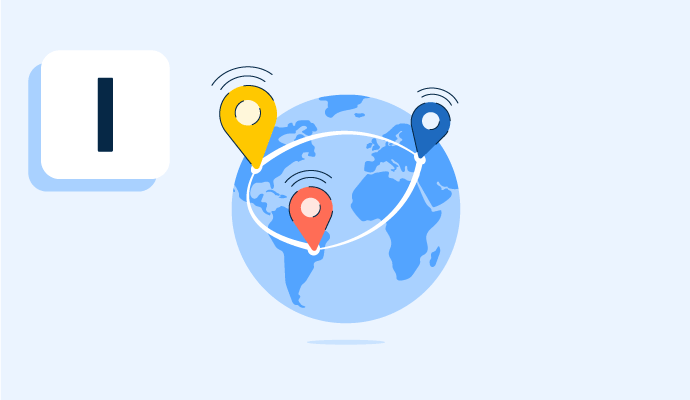What is an IP address?
An Internet Protocol (IP) address is a unique identifier assigned to an internet-connected device. It comprises a string of numbers separated by dots. IP addresses are used as digital addresses for devices that reveal some information about the user.
Internet service providers (ISPs) assign unique IP addresses to internet-connected devices. Desktop computers, laptops, tablets, mobile phones, and routers all have IP addresses. IP addresses allow these devices to send and receive information.
Businesses use IP address intelligence software to de-anonymize business-to-business (B2B) and business-to-consumer (B2C) web traffic, which lets them identify new professional opportunities, uncover trends, and enhance marketing campaigns. Companies turn to these tools to estimate the real-world location of internet-connected devices based on IP addresses.
What is the purpose of an IP address?
An IP address ensures that data gets sent to the right location. Similar to addresses for physical mail, internet-connected devices require some form of identification to send and receive data. Internet-connected devices cannot connect to or use the internet without an IP address.
History of IP addresses
The first public IP version, IPv4 (signifying version four), was created in 1981. IPv4 uses 32-bit addresses and is most commonly seen in dot-decimal notation. The notation consists of four octets. The octets are represented by decimal numbers between 0 and 255 separated by periods.
The Internet Engineering Task Force (IETF) and the Internet Assigned Numbers Authority (IANA) have special-use addresses reserved for particular purposes. Below is an example of an IPv4 address:
172.11.134.2
The IPv4 design needed to account for the rapidly growing number of internet users. Throughout the 1980s, it quickly became apparent that the pool of available IPv4 addresses was depleting more quickly than anticipated. The IETF developed IPv6, the most recent version of IP, to address the problem of IPv4 address exhaustion. IETF formalized IPv6 by 1998 with the intention of replacing IPv4.
IPv6 uses 128-bit addresses, offering significantly more addresses than IPv4. IPv6 addresses consist of eight groups of four hexadecimal values between 0 and FFFF separated by colons. It is important to note that IPv4 and IPv6 weren’t designed with interoperability, so they can’t communicate with each other. Below is an example of an IPv6 address:
2002:AC4:2233:4444:C067:DDDD:3654:5678
Basic parts of IPv4 addresses
IPv4 addresses consist of these two distinct parts:
- Network ID: Computers on the same network share a network ID. This part of the IP address conveys which network the host belongs to. Network IDs are assigned by an ISP, company network, or public network, depending on the type.
- Host ID: Each device has its own unique host ID. Hosts can communicate directly with other hosts on the same network. The network ID is the same for each device on a network, but the host ID is different because it is used to identify each host.
Basic parts of IPv6 addresses
IPv6 addresses consist of three components:
- The site prefix. Similar to the network ID in IPv4, the site prefix is the number assigned by an ISP.
- The subnet ID. This part of the address is private and represents the topology of the network’s site. The subnet ID defines a network subnet; 16 bits in length.
- The interface ID. Similar to the host ID in IPv4, this element identifies the individual host on the network.
Types of IP addresses
Four main types of IP addresses are used today. The first two below detail the network’s location, and the latter two indicate the network’s permanency.
- Public: A public IP address is associated with an entire network. All internet-connected devices in that network share the same IP address. ISPs provide public IP addresses to routers. A public IP address connects users to the internet outside their network.
- Private: Private IP addresses are assigned to each device that connects to a home network. Each device in the same network receives a unique private IP address. That is, computers, tablets, smartphones, and other devices in a household have separate, private IP addresses.
- Static: A static IP address is one that never changes. Static IP addresses are consistent and stay the same once their ISPs assign them to a device.
- Dynamic: A dynamic IP address is temporary and constantly changes over time. Dynamic IP addresses are assigned by a Dynamic Host Configuration Protocol (DHCP) server.
What information do IP addresses reveal?
An IP address reveals users’ geolocation. This doesn’t include precise location information, but an IP address might disclose a user’s city, ZIP code, or area code. While IP addresses do not explicitly expose a user’s identity, physical location attributes can make it easier to discover a user and track their activity.
What parties might be interested in accessing IP addresses?
Although IP addresses don’t reveal personal information or confidential data, some parties have various reasons for accessing IP addresses. Some examples include:
- Advertisers and retailers who want to target users with relevant products and services.
- Employers that need to understand how employees are spending their time online during working hours.
- Authorities piecing together illegal activities or tracing actions leading up to crimes.
- Cybercriminals attempting to create a Distributed-Denial-of-Service (DDoS) attack or install malware on devices.
Learn how to protect IP addresses with virtual private networks (VPNs).

Alyssa Towns
Alyssa Towns works in communications and change management and is a freelance writer for G2. She mainly writes SaaS, productivity, and career-adjacent content. In her spare time, Alyssa is either enjoying a new restaurant with her husband, playing with her Bengal cats Yeti and Yowie, adventuring outdoors, or reading a book from her TBR list.

